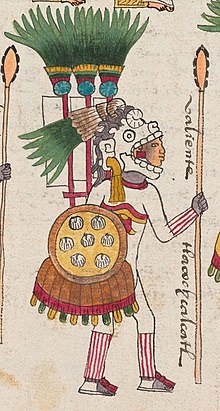| Tlacaelel | |
|---|---|
| Tlacochcalcatl of Tenochtitlan | |
 Tlacaelel was a tlacochcalcatl. Picture from Codex Mendoza. Tlacaelel was a tlacochcalcatl. Picture from Codex Mendoza. | |
| Born | 1397 Tenochtitlan |
| Died | 1487 (aged 89-90) Aztec Empire |
| Spouse | Maquiztzin |
| Issue | Cacamatzin Tlilpotoncatzin Xiuhpopocatzin Acihuapoltzin |
| Father | Emperor Huitzilihuitl |
| Mother | Queen Cacamacihuatl |
Tlacaelel I (1397 – 1487) (Classical Nahuatl: Tlācaēllel Nahuatl pronunciation: [t͡ɬaːkaˈeːlːel], "Man of Strong Emotions," from "tlācatl," person and "ēllelli," strong emotion) was the principal architect of the Aztec Triple Alliance and hence the Mexica (Aztec) empire. He was the son of Emperor Huitzilihuitl and Queen Cacamacihuatl, nephew of Emperor Itzcoatl, father of poet Macuilxochitzin, and brother of Emperors Chimalpopoca and Moctezuma I.
During the reign of his uncle Itzcoatl, Tlacaelel was given the office of Tlacochcalcatl, but during the war against the Tepanecs in the late 1420s, he was promoted to first adviser to the ruler, a position called Cihuacoatl in Nahuatl, an office that Tlacaelel held during the reigns of four consecutive Tlatoque, until his death in 1487.
Tlacaelel recast or strengthened the concept of the Aztecs as a chosen people, elevated the tribal god/hero Huitzilopochtli to top of the pantheon of gods, and increased militarism. In tandem with this, Tlacaelel is said to have increased the level and prevalence of human sacrifice, particularly during a period of natural disasters that started in 1446 (according to Diego Durán). Durán also states that it was during the reign of Moctezuma I, as an invention of Tlacaelel that the flower wars, in which the Aztecs fought Tlaxcala and other Nahuan city-states, were instigated.
To strengthen the Aztec nobility, he helped create and enforce sumptuary laws, prohibiting commoners from wearing certain adornments such as lip plugs, gold armbands, and cotton cloaks. He also instigated a policy of burning the books of conquered peoples with the aim of erasing all memories of a pre-Aztec past.
When he dedicated the seventh reconstruction of the Templo Mayor in Tenochtitlan, Tlacaelel had brought his nation to the height of its power. The dedication took place in 1484 and was celebrated with the sacrifice of many war captives. After Tlacaelel's death in 1487, the Mexica Empire continued to expand north into the Gran Chichimeca and south toward the Maya lands.
In popular culture
He was the inspiration for the main character in the novel, "Tlacaelel, El Azteca entre los Aztecas", by Mexican author Antonio Velasco Piña.
References
- Sometimes Tlacaélel's birth year is listed as 1398; see, e.g.: Mann, Charles C. (2005), 1491: New Revelations of the Americas Before Columbus, New York: Knopf, p. 118, ISBN 1-4000-4006-X.
- Sometimes Tlacaélel's birth year is listed as 1398; see, e.g.: Mann, Charles C. (2005), 1491: New Revelations of the Americas Before Columbus, New York: Knopf, p. 118, ISBN 1-4000-4006-X.
- Durán, Diego, History of the Indies of New Spain, Norman, OK: University of Oklahoma Press, 1994, pp. 74–101, ISBN 0-8061-2649-3.
- Malmstrom, Vincent H. (1997), Cycles of the Sun, Mysteries of the Moon: The Calendar in Mesoamerican Civilization, Austin, TX: University of Texas Press, p. 238, ISBN 0-292-75196-6.
- Brotherston, Gordon (1974), "Huitzilopochtli and What Was Made of Him", p. 159 in Hammond, Norman (ed.) (1974), Mesoamerican Archaeology - New Approaches: Proceedings of a Symposium on Mesoamerican Archaeology held by the University of Cambridge Centre of Latin American Studies, August 1972, Austin, TX: University of Texas Press, pp. 155–66, ISBN 0-292-75008-0.
- Burke, John Francis (2002), Mestizo Democracy: The Politics of Crossing Borders, College Station: Texas A & M University Press, p. 137, ISBN 1-58544-208-9.
- Ostler, Nicholas (2005), Empires of the Word: A Language History of the World, New York: HarperCollins, p. 354 ISBN 0-06-621086-0.
- Madrid Codex, VIII, 192v, as quoted in León-Portilla, p. 155. León-Portilla, Miguel (1963). Aztec Thought and Culture: A Study of the Ancient Náhuatl Mind. Civilization of the American Indian series, no. 67. Jack Emory Davis (trans.). Norman: University of Oklahoma Press. OCLC 181727. Note that León-Portilla finds Tlacaelel to be the instigator of this burning, despite lack of specific historical evidence.
- SilverMoon. "FRAY BERNARDINO DE S AHAGUN AND THE NAHUA: CONFLICTING INTERESTS INTERTWINED" (PDF). scholarworks. Montana State University. Archived from the original (PDF) on 12 September 2020. Retrieved 5 May 2019.
- Schroeder, Susan (2016). Talcaelel Remembered: Mastermind of the Aztec Empire. University of Oklahoma Press.
| Preceded byItzcoatl | Tlacochcalcatl | Succeeded byMoctezuma I |
| Preceded bynone | Cihuacoatl | Succeeded byTlilpotonqui |